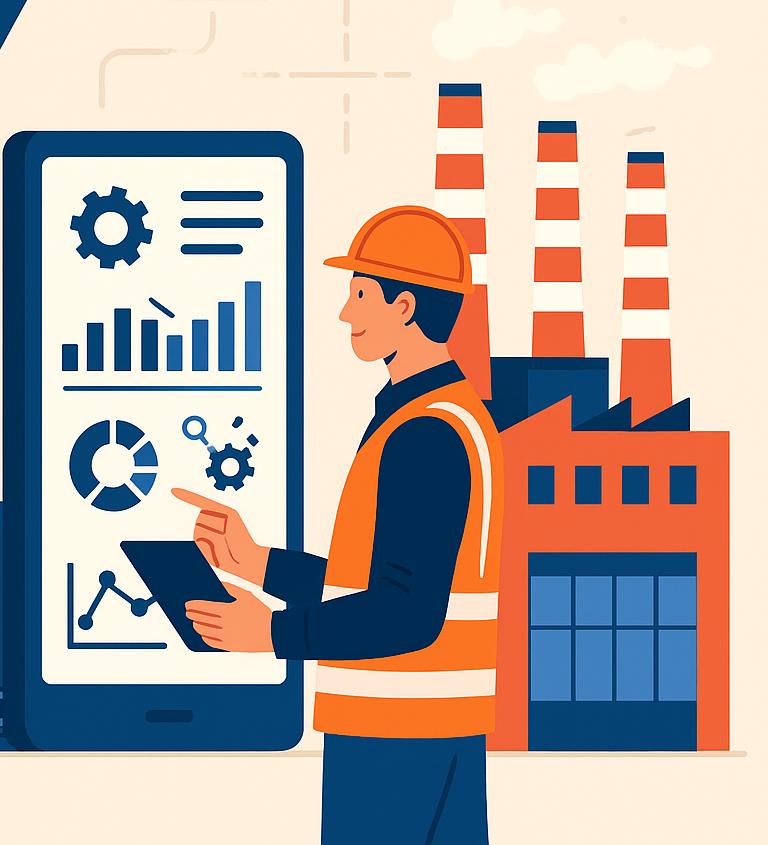Blog on RFID Technology and IoT Solutions
Blog Home
Top 7 Ways IoT Solutions Are Transforming the Indian Manufacturing Sector in 2025
05 August 2025India’s manufacturing sector, once infamous for being sluggish in adopting digital transformation, is now undergoing a revolutionary transformation — powered by the Internet of Things (IoT). It is 2025, and smart factories are no longer the future but a growing reality in India’s manufacturing sector. With the Indian government’s Make in India 2.0 initiative and a rise in private investment, IoT has become the foundation of smart manufacturing.
In this blog, we explore the top 7 ways IoT solutions are revolutionizing the Indian manufacturing industry in 2025, driving efficiency, sustainability, and innovation.
1. Real-Time Monitoring and Predictive Maintenance
From Downtime to Uptime
IoT-enabled sensors now track equipment in real-time in Indian factories — from Pune’s auto hubs to Tamil Nadu’s textile mills. These sensors track **temperature, vibration, pressure, and energy consumption**, sending alerts to teams for abnormalities before failure occurs.
Predictive maintenance reduces unplanned downtime by up to 40%, crores of rupees are saved in repair costs.
GE Predix and TCS’ IoT Framework are being customized to fit Indian SMEs for cost-effectiveness and scalability.
2. Smart Energy Management
From High Bills to Smart Savings
Energy is a significant portion of manufacturing cost. IoT solutions are enabling factories to monitor and optimize energy consumption** across equipment and processes.
AI-driven analytics software and smart meters are helping Indian companies like JSW Steel and Tata Motors reduce energy wastage by 15-25%.
Integration with renewable energy (solar, wind) is becoming seamless with IoT-enabled energy dashboards.
3. Quality Control using Vision Systems
From Human Error to Machine Precision
AI-enabled IoT vision systems inspect products on the assembly line in real-time, identifying defects that cannot be seen by the human eye.
Machine learning algorithms and IoT cameras are revolutionizing sectors like electronics and pharmaceuticals, where precision is absolute.
Indian startups like Lemnisk and Unbox Robotics are at the forefront of AI-driven quality inspections.
4. Supply Chain Transparency
From Black Boxes to Transparent Logistics
Supply chain disruption due to COVID-19 taught a good lesson to Indian manufacturers. In 2025, IoT devices are being incorporated into containers, pallets, and fleet vehicles to deliver end-to-end visibility.
Sensors provide real-time information on location, temperature, and condition** of goods during transportation.
Companies are pairing IoT with blockchain to create tamper-proof records of every stage, especially for perishable products and pharmaceuticals.
5. Worker Safety and Efficiency
From Risk Zones to Safe Zones
In hazardous sectors like chemical, oil & gas, and mining , IoT wearables are keeping Indian workers safe.
Smart helmets and wristbands monitor worker fatigue, gas leaks, and falls, providing real-time alerts.
Wearables with biometric sensors help HR and safety teams ensure compliance and avoid workplace accidents.
6. Smart Inventory Management
From Overstocking to Just-In-Time
IoT sensors in warehouses and storage units are tracking inventory in real time.
IoT scales, smart shelves, and RFID tags allow manufacturers to have **precise stock levels, reorder points, and expiry dates.
ERP systems integrated with IoT are allowing auto-replenishment, eliminating manual errors and reducing holding costs.
7. Data-Driven Decision Making
From Guesswork to Insight
In 2025, data is the new oil — and IoT is the refinery. Manufacturing managers now rely on real-time IoT dashboards for every decision.
Whether optimizing a production schedule, reducing carbon emissions, or planning maintenance windows, decisions are now taken on the basis of live, actionable insights.
Indian platforms like Bosch India’s Phantom IoT Suite and L&T’s SmartWorld are providing localized solutions appropriate for Indian manufacturers.
Final Thoughts: A Smarter, Stronger India
As India speeds toward a $5 trillion economy, its manufacturing base is transforming into a smart, connected ecosystem. IoT is not just a technology; it is a strategic enabler of resilience, efficiency, and sustainability.
With supportive government policies, 5G launch, and a widening pool of tech-savvy talent, IoT in Indian manufacturing will only evolve at a frenetic pace post-2025. The mantra for industry? Start small, scale fast, and stay smart.
- Intellistride.com
- Blog
- Top 7 Ways IoT Solutions Are Transforming the Indian Manufacturing…